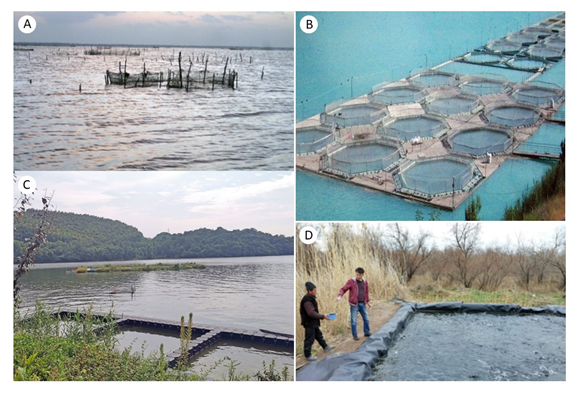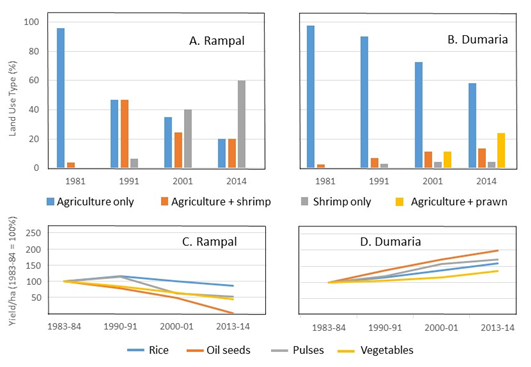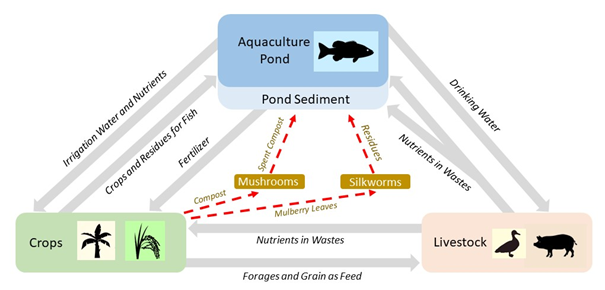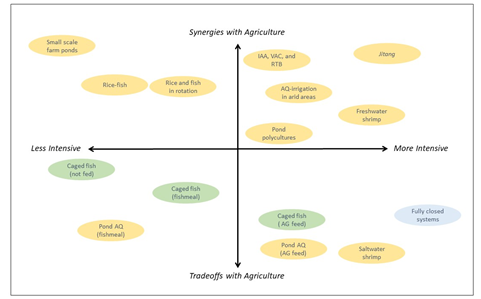Although agriculture and aquaculture depend on access to increasingly scarce, shared water resources to produce food for human consumption, they are most often considered in isolation. We argue that they should be treated as integrated components of a single complex system that is prone to direct or indirect tradeoffs that should be avoided while also being amenable to synergies that should be sought. Direct tradeoffs such as competition for space or the pollution of shared water resources usually occur when the footprints of agriculture and aquaculture overlap or when the two practices coexist in close proximity to one another. Interactions can be modulated by factors such as hydropower infrastructure and short-term economic incentives, both of which are known to disrupt the balance between aquaculture and agriculture. Indirect tradeoffs, on the other hand, play out across distances, i.e., when agricultural food sources are diverted to feed animals in aquaculture. Synergies are associated with the culture of aquatic organisms in rice paddies and irrigation waters, seasonal rotations of crop cultivation with aquaculture, and various forms of integrated agriculture–aquaculture (IAA), including jitang, a highly developed variant of pond-dike IAA. Policy decisions, socioeconomic considerations, and technology warrant increased scrutiny as determinants of tradeoffs and synergies. Priority issues for the future include guiding the expansion of aquaculture from its traditional base in Asia, taking advantage of the heterogeneity that exists within both agricultural and aquaculture systems, the development of additional metrics of tradeoffs and synergies, and adapting to the effects of climate change.
- water–energy–food
- fish ponds
- rice–fish
- shrimp farming
- Mekong River
- dam construction
- Central Asia
- irrigation
1. Introduction
Figure 1. Examples of aquaculture facilities. (A). Simple fish cages in Sri Lanka. (B). Modern intensively managed fish pens in Uzbekistan. (C). Modular fish enclosures in China. (D). Plastic-lined fish pond in Kazakhstan. Picture credits: (A) and (D), S. Pueppke; (B), N. Graham; (C), W. Zhang.
Table 1. Diversity of aquaculture systems.
|
System (examples) |
Characteristics |
|
Open (Enclosures in lakes, rivers, and reservoirs)
|
Relies on natural processes Investment ranges from low to high Scalable, can be made intensive
|
|
Partially closed (Ponds, irrigation canals, flooded agricultural fields)
|
Suitable for smallholders Extensive to highly intensive Amenable to integrated agriculture-aquaculture (IAA)
|
|
Fully closed (Recirculating aquaculture facilities, hydroponic systems) |
Complete environmental control High efficiency and productivity Requires significant investment and management |
Figure 2. Changes in land use between 1981 and 2014 in the Rampal (A) and Dumaria (B) sub-districts of Bangladesh as well as trends in crop production/ha in Rampal (C) and Dumaria (D) from 1983–1984 to 2013–2014. The original data are from Islam and Tabita [1].
Figure 3. Schematic diagram of nutrient flows in integrated agriculture–aquaculture (IAA) systems involving fish, crops, and terrestrial farm animals. The flows of the generic system are depicted with gray arrows. Additional flows characteristic of the jitang system are indicated with dashed red arrows. For more detailed diagrammatic representations, see [2] and [3].
Figure 4. Quadrant analysis of synergies and tradeoffs between agriculture and various forms of aquaculture (y-axis) verses intensiveness of the aquaculture practices (x-axis). Aquaculture categories are color-coded as open (green), partially closed (orange), and closed (blue). Abbreviations are: AG, agriculture; AQ, aquaculture; IAA, integrated agriculture–aquaculture; VAC, Vietnamese garden–pond–livestock; RTB, roots–tubers–bananas.
Although often treated in isolation, agriculture and aquaculture have much in common: both have the production of food as their primary objective, are co-dependent on water and land as shared resources, and seek to function in harmony with the environment. There is growing awareness that agriculture and aquaculture are sub-components of a single system deserving of consideration from an integrated perspective. Figure 4 represents a simplified diagram of such a unified system. The relative positions of the categories represented by colored ovals is subjective, of course, and the range of variability that can exist within individual categories is absent. Nevertheless, the map provides an initial framework to visualize important, often overlooked relationships. Any effort at system-wide integration to reduce tradeoffs and enhance synergies among these relationships immediately confronts a spectrum of real world policy, socioeconomic, and technical issues. These issues are inseparable and usually spatially explicit. Temporal factors and considerations of scale and scope also figure prominently into any consideration of integration.
Policy has too often favored agriculture over aquaculture, especially for access to water. This bias, which occurs in both water-abundant and water-scarce regions, reinforces the shortsighted view that aquaculture is an isolated, subordinate sector and has contributed to actions that curb and even reverse the development of aquaculture in shared waters. The absence of policies supportive of aquaculture characterize much of arid Asia, and this, too, has constrained the development of IAA in irrigation waters. Other facets of policy, especially energy policies that promote hydropower development, create externalities that affect both agriculture and aquaculture. By altering sedimentation and flows, they can also disrupt the relationship between the two, often to benefit aquaculture. Therefore, policy functions as a tool—sometimes deliberate, sometimes unintentional—for adjustment of the balance between agriculture and aquaculture.
Although the socioeconomic aspects of agriculture–aquaculture–water relationships are sometimes neglected and often under-appreciated, they are at the heart of debates about the potential of aquaculture to help agriculture address poverty issues in rural areas. As illustrated by the growth of shrimp farming, opportunities for small farmers to benefit economically from aquaculture can lead to practices that render soils unfit for growing crops. Thus, the damage to agriculture can be permanent, even though the economic benefits of aquaculture may be short lived. Moreover, the intensification of aquaculture tends to marginalize poorer farmers, who have limited access to capital and other resources, in the process decoupling the potential benefits of aquaculture from those of agriculture.
Intensification and reliance on technology (Figure 4), including biotechnology, can nevertheless increase food productivity per unit of area and unit of water consumption while simultaneously generating other efficiencies, i.e., alleviating the need for scarce labor in small-scale IAA systems. However, technology and intensification can also create new tradeoffs by promoting crop monocultures and continuous aquaculture or rendering aquaculture dependent on agricultural feeds. It has also been noted that water problems tend to persist in spite of new technologies, which in the case of irrigation in arid areas, often simply facilitate the expansion of agriculture rather than the conservation of water.
The dynamics among the above factors highlight three issues that will undoubtedly define how future interrelationships between agriculture and aquaculture evolve. The first is a realization that although the current geographical intersection of agriculture and aquaculture is Asia, this will shift and significantly expand in the future as the latter gains a firmer foothold in other parts of the world. This is already occurring. Second, the heterogeneity and variability of water, agriculture, and aquaculture will command more attention as the effects of climate change spread and intensify. Factors such as the scope and scale of production, spatiotemporal relationships, dependence on transboundary waters, adjustment to changes brought on by large-scale hydraulic infrastructure, and competition with other users for increasingly scarce water will all assume increasing importance. The livestock component, which has undergone less quantitative analysis than crop-based agriculture—in part because it is less amenable to analysis by remote sensing—warrants more attention with respect to all of these issues.
Finally, there is a need for additional studies to identify the best methods to assess beneficial and detrimental relationships between agriculture and aquaculture as mediated by water. Figure 4 maps such relationships, but how can they best be measured, modeled, analyzed, and evaluated? We have focused here on commonly employed measures such as land and water footprints, soil and water quality, and food production. Nevertheless, others are available: food output as calories, protein, or other components of human nutrition; contributions to food security or to the national economy; achievement of desired socioeconomic goals; alleviation of poverty; and contribution to environmental sustainability. Each warrants further assessment in future considerations of water, agriculture, and aquaculture.
This article is from 10.3390/w12102787.
This entry is adapted from the peer-reviewed paper 10.3390/w12102787
References
- Islam, M.R.; Tabeta, S. Shrimp vs prawn-rice farming in Bangladesh: A comparative impacts study on local environments and livelihoods. Ocean. Coast. Manag. 2019, 168, 167–176, doi:10.1016/j.ocecoaman.2018.11.004.
- Little, D.C.; Edwards, P. Integrated Livestock-Fish. Farming Systems; United Nations Food and Agriculture Organization: Rome, Italy, 2003.
- Ruddle, K.; Furtado, J.I.; Zhong, G.F.; Deng, H.Z. The mulberry dike-carp pond resource system of the Zhujiang (Pearl River) Delta, People’s Republic of China; I. Environmental context and system overview. Appl. Geog. 1983, 3, 45–62.




